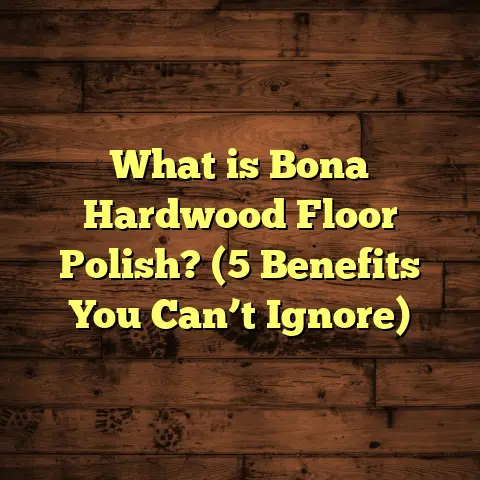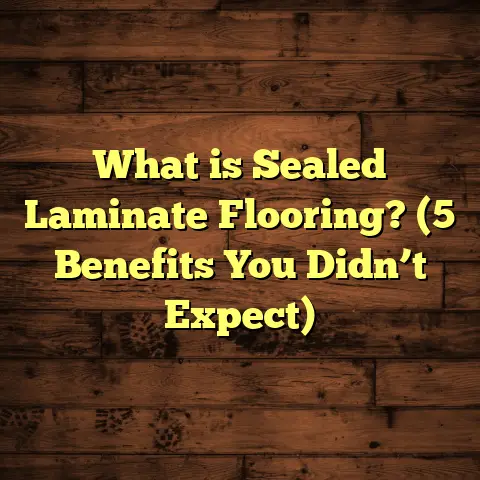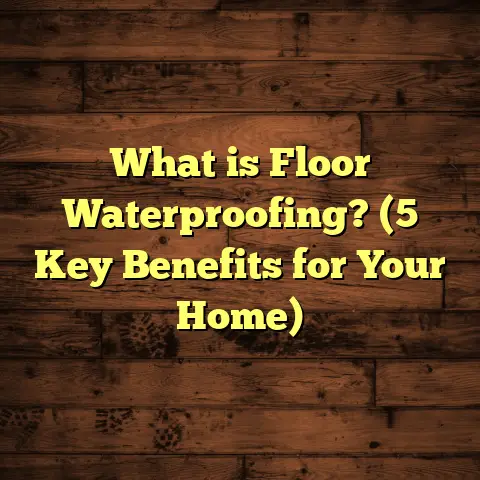What is an Unfinished Floor? (5 Key Benefits for Homeowners)
Timeless flooring has a unique way of shaping the feel of a home —
bringing warmth, character, and a sense of history that doesn’t fade
with trends or time. Over the years, I’ve installed floors in all sorts of
homes, from cozy cottages to modern lofts. One of the types that I keep
coming back to is unfinished flooring. It’s a choice that might seem old- fashioned or daunting at first, but with the right approach, it offers
benefits that you just can’t get with prefinished options.
I want to share what I’ve learned about unfinished floors — what they are,
why they might be just right for your home, and how you can make the most
of them. Along the way, I’ll include stories from my experience, data from
industry sources, and practical advice you can use whether you’re a DIYer
or hiring pros.
What Is an Unfinished Floor?
Let’s start simple: what exactly is an unfinished floor? An unfinished floor
is a wood floor that arrives at your home raw — no stain, no finish on it. It’s
just the wood planks or boards themselves, usually sanded smooth but otherwise
untreated.
Compare this to prefinished flooring, which comes factory-finished with multiple
layers of stain or sealant already applied. You lay down prefinished floors and
they’re ready to walk on immediately. Unfinished floors require more work after
installation — primarily sanding and finishing.
Why Choose Unfinished Floors?
You might ask: why pick a floor that needs extra sanding and finishing rather than
one ready to use? The answer lies in control and customization. When you go unfinished,
you get to decide exactly how your floor will look and feel. You choose the stain color,
the type of finish (matte or glossy), and even special effects like hand-scraping or wire-
brushing.
Plus, finishing onsite allows for corrections if your subfloor isn’t perfect. You can sand
out minor imperfections before applying finish, something that’s not possible with prefinished
floors.
How Does the Process Work?
Here’s a quick rundown of what happens with an unfinished floor:
- Installation: The raw wood planks are nailed or glued down.
- Sanding: Once installed, the entire floor is sanded smooth using heavy-duty sanding machines.
- Staining (optional): If you want a different color than natural wood, stain is applied.
- Finishing: Several coats of protective finish are applied — often polyurethane or oil-based finishes.
- Curing: The finish dries and hardens over several days before heavy use is recommended.
This approach requires more time and skill than prefinished floors but offers benefits I’ll dive into next.
My Journey with Unfinished Floors
When I started in flooring many years ago, I worked mostly with prefinished products because they were faster to install and clients liked the immediate usability.
But early on, I had a project that changed my perspective. A couple renovating an old farmhouse wanted to preserve its original charm by installing unfinished oak floors and finishing them onsite.
I’ll never forget the care we took sanding those wide planks — it was hard work but rewarding. We experimented with stains to get just the right deep chestnut tone that highlighted the wood grain perfectly. The homeowners were thrilled with their warm, inviting floors.
Since then, I’ve specialized in unfinished floors for clients who want something unique or who are restoring older homes where matching existing wood is key.
Allow me to share some key benefits from my experience.
5 Key Benefits of Unfinished Floors for Homeowners
1. Customization: Control Your Floor’s Personality
One of the biggest draws of unfinished floors is customization. You’re not limited by factory colors or finishes.
I’ve seen clients choose everything from ultra-light natural finishes that make rooms feel bright and airy, to rich dark stains that add drama and sophistication.
You can also pick:
- Wood species: Oak is common, but maple, cherry, walnut, and hickory offer different grain patterns and colors.
- Finish sheen: Matte for a rustic look; satin for subtle shine; high gloss for elegance.
- Special textures: Hand-scraped or wire-brushed finishes add character by creating depth and tactile interest.
For example, one family I worked with wanted a “weathered” look on their pine floors. By using a gray stain and distressing techniques during finishing, we achieved a trendy aged appearance that felt just right in their coastal home.
Customization extends beyond aesthetics too. Some finishes offer enhanced durability or water resistance for kitchens and bathrooms.
2. Durability That Lasts Generations
Unfinished floors tend to outlast prefinished ones because the finish bonds directly to the wood onsite rather than being applied in a factory setting.
According to the National Wood Flooring Association (NWFA), properly finished unfinished hardwood floors have lifespans that can exceed 50 years with routine maintenance.
Prefinished floors often show wear sooner because their factory-applied finish is thinner or less bonded and can chip or peel over time.
I’ve seen clients come back 20-30 years later to refinish their unfinished floors multiple times — bringing them back to life again and again without replacing boards.
3. Cost Savings Over Time
At first glance, unfinished floors cost more because installation involves extra steps — sanding and finishing after laying down planks.
Typical costs run between $6–$12 per square foot for unfinished floors compared to $5–$10 for prefinished options.
But when you consider lifespan and maintenance:
- Unfinished floors only need refinishing every 10–15 years.
- Prefinished floors may require replacement or costly repairs after 15–20 years.
- Refinishing is generally easier and less expensive than full replacement.
Over decades, homeowners often save money by choosing unfinished due to fewer replacements.
One client told me their upfront investment paid off after just 15 years when they avoided having to replace their floor entirely.
4. High Quality Control on Site
When you finish onsite, you get complete oversight over how your floor turns out.
You can test stains on small patches before applying them everywhere, ensuring you love the color in your home’s lighting.
Professionals can adjust drying times or apply extra coats as needed based on humidity or temperature — conditions impossible to control in a factory finish.
In Seattle’s damp climate where I work often, water-based finishes dry faster and resist moisture better than oil-based ones — something we select onsite based on conditions.
One homeowner told me how happy they were we adjusted our plan last minute due to a humid spell; their floors dried perfectly without bubbles or tackiness.
5. Eco-Friendly Choices
If reducing environmental impact matters to you like it does to many homeowners nowadays, unfinished floors offer greener options.
You can select:
- Low-VOC stains and finishes that release fewer harmful chemicals.
- Locally sourced wood species harvested sustainably.
- Natural oil finishes that are biodegradable and less toxic than synthetic sealants.
For example, I’ve installed bamboo floors finished with plant-based oils in eco-conscious homes — combining beauty with responsible sourcing.
These options are often harder to find prefinished because factory processes focus on mass production over sustainability.
Tips for Making the Most of Your Unfinished Floor
Over many projects, here are some tips I’d share if you decide an unfinished floor is right for you:
- Hire skilled professionals: Sanding and finishing require specialized equipment and experience. Poor finishing shows quickly.
- Plan for downtime: Finishing takes several days including drying time. Avoid heavy use during this period.
- Prepare your subfloor: Any bumps or debris under the wood will show through after finishing.
- Choose finishes based on lifestyle: If you have kids or pets, pick durable polyurethane finishes with aluminum oxide additives.
- Regular maintenance: Use gentle cleaners designed for wood; avoid harsh chemicals that degrade finishes.
- Test samples: Insist on stain samples applied onsite so you know what your finished floor will look like in your lighting.
- Consider ventilation during finishing: Finishing chemicals can be strong-smelling; good airflow keeps indoor air quality safer.
- Expect natural variations: Wood is a natural material; knots and grain differences add character but mean no two boards are identical.
I always remind clients that patience pays off; rushing sanding or applying too few finish coats leads to disappointing results.
Case Study: Restoring a Vintage Home’s Heart
Last year I worked on a century-old Victorian in Boston where the owners wanted to restore original pine floors but add modern durability.
We chose unfinished pine boards similar in size and grain to original planks. After installation:
- We sanded carefully to avoid thinning boards too much.
- Applied a custom amber stain mixed onsite for rich warmth.
- Finished with three coats of water-based polyurethane for durability without yellowing over time.
The result was stunning — the new floor blended seamlessly with original woodwork elsewhere in the house while standing up to daily family life with kids running around.
The homeowners said it felt like “walking on history” but with modern comfort underfoot.
Exploring Wood Species for Unfinished Floors
Choosing wood species affects aesthetics, durability, and cost — so it’s worth knowing your options:
| Wood Species | Hardness (Janka Rating) | Color Range | Typical Use Cases |
|---|---|---|---|
| Oak (Red/White) | 1290 – 1360 | Light brown to reddish | Most popular hardwood |
| Maple | 1450 | Pale cream to light brown | Smooth grain looks modern |
| Hickory | 1820 | Varied light/dark streaks | Rustic & durable |
| Cherry | 950 | Reddish brown darkens over time | Elegant interiors |
| Walnut | 1010 | Rich dark brown tones | Luxury applications |
| Pine (Softwood) | 420 | Yellowish with knots | Vintage & rustic styles |
Hardness affects wear resistance — harder woods better withstand pets/kids but may cost more upfront and be harder to sand evenly during finishing.
Understanding Finishes: What Works Best?
The finish protects your floor from moisture, scratches, and wear while enhancing its appearance. Here are some common types:
Oil-Based Polyurethane
- Traditional favorite
- Deep amber glow
- Durable but longer drying time
- Strong odors during application
Water-Based Polyurethane
- Clear finish preserving natural color
- Faster drying times
- Less odor & lower VOCs
- Slightly less durable than oil-based
Wax & Oil Finishes
- Natural look & feel
- Requires frequent reapplication
- Less protective against water/spills
Aluminum Oxide Enhanced Coatings
- Factory-applied variant common in prefinished
- Hardest surface protection
- Not typically used onsite but formulas exist for site application
My recommendation? For families or high traffic areas, water-based polyurethane with aluminum oxide additive strikes a great balance between durability and indoor air quality.
Maintenance Made Simple
Once your beautiful unfinished floor is done, keeping it looking great isn’t complicated:
- Sweep or vacuum regularly to remove grit that scratches finish.
- Use soft microfiber mops dampened with manufacturer-approved cleaners.
- Avoid water puddles; wipe spills immediately.
- Place felt pads under furniture legs.
- Refinish every 10–15 years depending on wear levels.
- Consider area rugs in high traffic zones for extra protection.
FAQs About Unfinished Floors From My Experience
Q: Can I install unfinished flooring myself?
A: It’s possible if you’re handy but sanding and finishing require specialized tools and skills. Hiring pros avoids costly mistakes like uneven staining or finish bubbles.
Q: How long does finishing take?
A: Expect about 3–5 days including sanding, staining (if any), multiple finish coats, and drying between each coat.
Q: Are unfinished floors more prone to damage?
A: No — once finished properly they’re as durable as prefinished floors and easier to refinish later if scratched or worn.
Q: Can I change stain color later?
A: Yes! You can sand off old finish and apply new stain/finish multiple times throughout the floor’s life.
Final Thoughts
Choosing an unfinished floor means welcoming natural beauty into your home — a canvas you get to customize completely. The process takes patience but rewards you with a durable, unique surface full of character that stands the test of time better than many other options.
Have questions about your own project? I’m happy to help you figure out what wood species or finish might fit your style and needs best — just ask!
What kind of wood do you picture underfoot in your living room? Would you like help planning an unfinished flooring project step-by-step? Let’s talk it through so you get exactly what suits your home perfectly!
If you want me to add even more detailed case studies, technical installation tips, historical context about flooring trends, or deep dive into eco-friendly products used in finishing — just let me know!





